

Quark. A quark (/ˈkwɔrk/ or /ˈkwɑrk/) is an elementary particle and a fundamental constituent of matter.

Quarks combine to form composite particles called hadrons, the most stable of which are protons and neutrons, the components of atomic nuclei.[1] Due to a phenomenon known as color confinement, quarks are never directly observed or found in isolation; they can be found only within hadrons, such as baryons (of which protons and neutrons are examples), and mesons.[2][3] For this reason, much of what is known about quarks has been drawn from observations of the hadrons themselves. The quark model was independently proposed by physicists Murray Gell-Mann and George Zweig in 1964.[5] Quarks were introduced as parts of an ordering scheme for hadrons, and there was little evidence for their physical existence until deep inelastic scattering experiments at the Stanford Linear Accelerator Center in 1968.[6][7] Accelerator experiments have provided evidence for all six flavors.
Classification[edit] World-Mysteries.com. Peter Diamandis on Stephen Hawking in zero g. Steve Truglia: A leap from the edge of space. Tom Shannon's anti-gravity sculpture. Andrea Ghez: The hunt for a supermassive black hole. The laws list. TOP UNSOLVED PROBLEMS IN PHYSICS. The sound of silence. Thinking like Sherlock Holmes. 101 Websites for Science Teachers. SmarterEveryDay. Twitter SmarterEveryDay Loading...

Working... MinutePhysics. How Much Does a Shadow Weigh? Vortexal energy. Vortex. Gravitational Cosmology. Electromagnetic spectrum. The electromagnetic spectrum is the range of all possible frequencies of electromagnetic radiation.[4] The "electromagnetic spectrum" of an object has a different meaning, and is instead the characteristic distribution of electromagnetic radiation emitted or absorbed by that particular object.
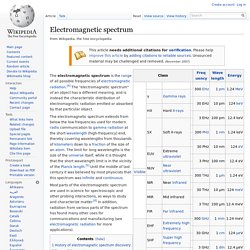
Most parts of the electromagnetic spectrum are used in science for spectroscopic and other probing interactions, as ways to study and characterize matter.[6] In addition, radiation from various parts of the spectrum has found many other uses for communications and manufacturing (see electromagnetic radiation for more applications). History of electromagnetic spectrum discovery The first discovery of electromagnetic radiation other than visible light came in 1800, when William Herschel discovered infrared radiation.[7] He was studying the temperature of different colors by moving a thermometer through light split by a prism. He noticed that the highest temperature was beyond red.
Matter is Vibrating. Water has Memory. 5 Really Weird Things About Water. Water, good ol' H2O, seems like a pretty simple substance to you and me.

But in reality, water - the foundation of life and most common of liquid - is really weird and scientists actually don't completely understand how water works. Here are 5 really weird things about water: 1. Hot Water Freezes Faster Than Cold Water Take two pails of water; fill one with hot water and the other one with cold water, and put them in the freezer. Top 10 Stars That'll Blow Your Mind. Space No one can help but look at all the stars which adorn our skies and wonder, “what’s out there?”

It’s natural to dream about that which lies so very beyond our reach. Perhaps in a solar system far from ours there’s another species gazing up towards our sun, a mere point of light from their perspective, and wondering what mysteries it holds. Try as we might, we’ll never truly understand everything there is to know about cosmology, but it doesn’t stop us trying. From the known to the hypothetical, this list will outline ten fascinating types of stars. Photos: 65 All-Time Great Galaxy Hits. Dimension. A diagram showing the first four spatial dimensions. 1-D: Two points A and B can be connected to a line, giving a new line segment AB. 2-D: Two parallel line segments AB and CD can be connected to become a square, with the corners marked as ABCD. 3-D: Two parallel squares ABCD and EFGH can be connected to become a cube, with the corners marked as ABCDEFGH. 4-D: Two parallel cubes ABCDEFGH and IJKLMNOP can be connected to become a hypercube, with the corners marked as ABCDEFGHIJKLMNOP.
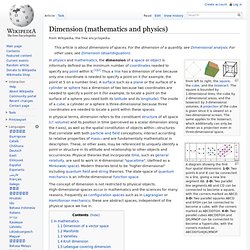
In physical terms, dimension refers to the constituent structure of all space (cf. volume) and its position in time (perceived as a scalar dimension along the t-axis), as well as the spatial constitution of objects within—structures that correlate with both particle and field conceptions, interact according to relative properties of mass—and are fundamentally mathematical in description. The concept of dimension is not restricted to physical objects. The Ultimate Field Guide to Subatomic Particles - io9. This is, for the most part, an accurate article, except for a few statements.
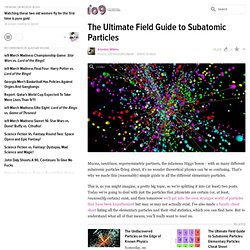
"Exactly what makes a fermion a fermion is a bit complicated, but suffice it to say that fermions are all the particles that deal with matter. So what about the last group of elementary particles, the ones that don't deal with matter? These are the bosons, and they deal with the fundamental forces of the universe. " How an Aurora Borealis works. The 7 Natural Laws of the Universe « Path to Enlightenment. The 7 Natural Laws of the Universe The Law of Attraction is just part of one of the 7 natural laws of the Universe: the Law of Vibration.
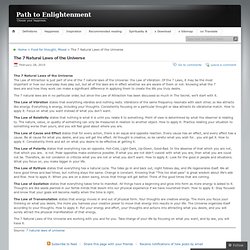
Of the 7 Laws, it may be the most important in how our everyday lives play out, but all of the laws are in effect whether we are aware of them or not. Knowing what the 7 laws are and how they work can make a significant difference in applying them to create the life you truly desire. The 7 natural laws are in no particular order, but since the Law of Attraction has been discussed so much in The Secret, we’ll start with it. The Law of Vibration states that everything vibrates and nothing rests. Vibrations of the same frequency resonate with each other, so like attracts like energy. The Law of Relativity states that nothing is what it is until you relate it to something.
The Law of Cause and Effect states that for every action, there is an equal and opposite reaction. The Law of Polarity states that everything has an opposite. Atomic Structure. An updated version of this lesson is available at Visionlearning: Atomic Theory & Ions & Isotopes In the last lesson we learned that atoms were particles of elements, substances that could not be broken down further. In examining atomic structure though, we have to clarify this statement. An atom cannot be broken down further without changing the chemical nature of the substance.
"Living" Crystal Colonies. A bacterium will group together with its neighbors to form a living colony, but what about non-living things?
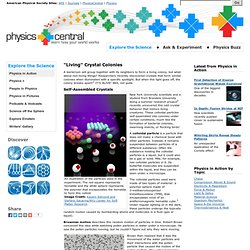
Researchers recently discovered crystals that form similar colonies when illuminated with a specific spotlight. But when this light goes off, the colony breaks apart! 1 IT'S ALIVE! Well, not quite. Self-Assembled Crystals New York University scientists and a student from Brandeis University doing a summer research project2 recently uncovered this odd crystal behavior that mimics living creatures. Shattering Science and Glass Physics. From windshields to coffee tables to high-rise office buildings, we are surrounded by glass.

But as any action movie stunt double will tell you, glass will break when you slam into it with enough force. Sometimes it breaks with devastating consequences, creating jagged shards that spray out in all directions. This can make a bad situation, like an automobile collision, much worse. High-risk applications like car windshields require a balance: glass that not only resists scratching and breaking but also breaks safely under an overwhelming force. Glass is strong but shows potential to be stronger, according to theoretical work by researchers at Rice University. Fundamental Forces. GCSE Physics Forces, Moments and Pressure Revision - Forces and Pressure. Think about these two situations: Pushing a drawing pin into a wall pointy end towards the wall.
Pushing a drawing pin into a wall pointy end towards your thumb. Two similar activities with two very different results. The reason for this is the difference in pressure. Travel INSIDE a Black Hole.